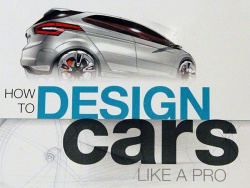 How to design cars like a pro. Click image to enlarge |
By Russell Purcell
You know this book was not slapped together when the likes of Ian Callum (Director of Design at Jaguar) takes the time to write the forward. In fact, the first edition of this book was released in 2003 and quickly became one of Motorbooks’ best- selling titles.
Co-authors Tony Lewin and Ryan Borroff have totally revised and updated the book so that it would be relevant to the times, and judging from the inclusion of some of the subject cars (recent models like the BMW Vision EfficientDynamics and Audi R8 Spyder), this book is hot off the presses.
The book takes an in-depth look at “fifty of the greatest automobile designs covering more than a century of automotive history.” After a brief introduction to explain how far the design world has progressed in the eight years since the first edition of the book was published, the reader is introduced to four of the most pre-eminent designers working in the automotive industry today – Marek Reichman (Aston Martin); Peter Schreyer (Kia); Anthony Lo (Renault); and Adrian van Hoodoik (BMW). These four influential men discuss how they got started, what inspires them, and what they consider to be their best work.
Chapter 2 looks at the evolution of a design from a simple sketch to the showroom floor. Jaguar’s new XJ Series, Chevrolet’s re-born Camaro, VW’s sporty Scirocco, and Nissan’s Juke are some of the cars showcased here. It soon becomes apparent that if the designers and engineers don’t find a way to work in harmony along the way, many of the design ideas will never make it beyond the conceptual stage and quickly be abandoned.
I found the third chapter to be eye-opening in that the authors examine how the designs of modern automobile interiors reflect “a cross pollination” of styling elements culled from other design spheres such as architecture, fashion, and product design. In the 21st Century, the automobile has become much more than a means of transportation for most people, as long commutes and the further integration of computerized systems, communications and entertainment systems have even the average consumer looking for a vehicle that offers maximum levels of comfort, versatility and technology in a single package that appeals to all the senses.
Concept cars represent the future trends in car design and signal the direction in which each individual car company is headed with their model line-up, but these multi-million dollar show pieces roll into the limelight just long enough to showcase a company’s projects. In Chapter 4, the authors discuss the reason these often flamboyant and over-the-top design exercises are produced as well as the various strategies behind them. I found this the most captivating chapter and would recommend this book based on its inclusion alone.











